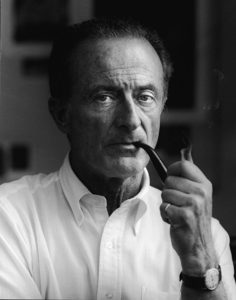Fred Zinnemann’s Act of Violence is one of the better film noirs of MGM, a studio that did not make many of them.
It’s a noir thriller with a social theme, dealing with what would become the director’s recurrent motif: the burden of guilty conscience and its consequences.
Photo: Director Fred Zinnemann
Our grade: B (*** out of *****)
Based on unpublished story by Collier Young, the tale deals with a disabled war veteran (Robert Ryan), who travels from the East to find a man (Van Heflin), a respected contractor responsible for the deaths of several men in a prison camp.
The contractor, guilt-ridden, is now married to a woman of dubious reputation, but his conscience continues to torment him, and at the end he sacrifices himself to save veteran.
Enley cant forget that his comrades were shot down, but his memory focuses on such marginal questions as the food, with which the enemy had rewarded him.
Meanwhile, the character of Parkson is not a complex one, for his wish for revenge is not based on a moral decision.
| Act of Violence | |
|---|---|

theatrical release poster
|
|
Though dealing with guilt and atonement, the social theme is not manifest forcefully enough, and the whole tone of the film is dispassionate, which is true of other Zinnemann films.
Visually, the film begins in daylight in unthreatening surroundings and proceeds to a seamier environment, as Enley journeys through the desperate night.
Distinguished lenser Robert Surtees contributes atmospheric night-for-night exteriors and evocatively lit interiors that are worthy of the best film noir.
Zinnemann’s direction is based on the contrasts of the two main characters.
The acting is decent but not great, and its interesting that protagonist and antagonist, played by Robert Ryan and Van Heflin respectively, never really share a scene together.
Until the resurgence of film noir as a genre, the movie received only scant critical attention and was seldom shown.
Zinnemann made Act of Violence during the “realist” phase of his career. Two better pictures would followed it, The Search, with Monty Clift, and The Men, which marked Brando’s screen debut.
What gives the film its noir qualities is not only the evocative renderings of the seamy side of the L.A. night world, but also the ambiguity of Heflin’s character. In the beginning, we have sympathy for him as we see him and his family being menaced by a revenge-filled psychopath (Ryan excelled in this type of role).
However, as the film progresses, we see Heflin as a moral coward, and by the end, the audience has little choice between the hunter and the hunted.
The drama itself lacks much credibility, and some of the encounters that Ryan has with the underworld are grotesque, but the grim mood established by Zinnemann is right–there’s added realism from the use of outdoor settings–and the story’s fast speed.
In other words, this is a cat-and-mouse thriller that’s made sharper by the smooth direction and compelling performances.
Act of Violence was the third film noir of Robert Ryan, who was borrowed by RKO from MGM, in 1948, after making Berlin Express and Return of the Badman.
On location shooting include the Big Bear Lake and Valley, San Bernardino National Forest, California.
Commercially speaking, the film was a flop at the box-office, but it did not damage Zinnemann’s future career.
Cast
Van Heflin as Frank R. Enley
Robert Ryan as Joe Parkson
Janet Leigh as Edith Enley
Mary Astor as Pat
Phyllis Thaxter as Ann Sturges
Berry Kroeger as Johnny
Taylor Holmes as Gavery
Harry Antrim as Fred Finney
Connie Gilchrist as Martha Finney
Will Wright as Pop
Credits
Directed by Fred Zinnemann
Produced by William H. Wright
Screenplay by Robert L. Richards
Story by Collier Young
Music by Bronislau Kaper
Cinematography Robert Surtees
Edited by Conrad A. Nervig
Production company: Metro-Goldwyn-Mayer
Distributed by Loew’s Inc.
Release date: January 22, 1949 (NYC)
Running time: 82 minutes
Budget $1.29 million











